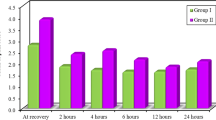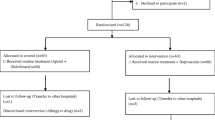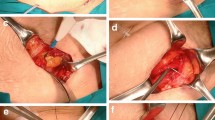Abstract
Background
A standard approach for postoperative analgesia in laparoscopic surgery is to infiltrate the incisions with local anesthetic in combination with systemic opioids. The intraperitoneal introduction of local anesthetic in this setting has the potential to provide appropriate analgesia without the side effects of systemic opioids. We performed a randomized clinical trial of the On-Q pump delivery system to determine the safety and efficacy of this device for this novel purpose.
Methods
Thirty patients undergoing laparoscopic adjustable gastric banding were randomly assigned to one of two groups. The treatment group received On-Q pump systems filled with 0.375% bupivacaine, while the control group received pumps filled with 0.9% normal saline. The pump’s catheter was introduced intraperitoneally, and bupivacaine or saline was then delivered for the first 48 h after surgery. Patient’s subjective pain scores were evaluated at preset intervals. In addition, shoulder pain, morphine requirements, and anti-emetic requirements were tabulated.
Results
A statistically significant decrease in patient’s subjective reports of pain by visual analog score was noted in the On-Q group 1.8 ± 1.93 vs. control 3.5 ± 2.4, p < 0.046 and remained significant until the end of the study (48 h). No statistical difference was noted in shoulder pain, morphine requirements, or anti-emetic requirements at any time point.
Conclusion
Our trial was able to provide evidence of significant reduction in postoperative pain as measured by subjective pain scores with the use of continuous intraperitoneal bupivacaine using the On-Q pain pump system. Further investigation is warranted to evaluate the cost effectiveness of this technique.





Similar content being viewed by others
References
Dahl JB, Moiniche S, Kehlet H. Wound infiltration with local anaesthetics for postoperative pain relief. Acta Anaesthsiol Scand 1994;38:7–14.
Moiniche S, Mikkelsen S, Wetterslev J, Dahl JB. A qualitative systemic review of incisional local anaesthesia for postoperative pain relief after abdominal surgery. Br J Anaesth 1998;81:377–83.
Ure BM, Troidl H, Spangenberger W, et al. Pain after laparoscopic cholecystectomy. Surg Endosc 1994;8:90–6.
Wallin G, Cassuto J, Högström S, Hedner T. Influence of intraperitoneal anesthesia on pain and the sympathoadrenal response to abdominal surgery. Acta Anaesthesiol Scand 1988;32(7):553–8.
Elfberg BA, Sjövall-Mjöberg S. Intraperitoneal bupivacaine does not effectively reduce pain after laparoscopic cholecystectomy: a randomized, placebo-controlled and double-blind study. Surg Laparosc Endosc Percutan Tech 2000;10(6):357–9.
Keita H, Benifla JL, Le Bouar V, Porcher R, Wachowska B, Bedairia K, Mantz J, Desmonts JM. Prophylactic ip injection of bupivacaine and/or morphine does not improve postoperative analgesia after laparoscopic gynecologic surgery. Can J Anaesth 2003;50(4):362–7.
Mraović B, Jurisić T, Kogler-Majeric V, Sustic A. Intraperitoneal bupivacaine for analgesia after laparoscopic cholecystectomy. Acta Anaesthesiol Scand 1997;41(2):193–6.
Szem JW, Hydo L, Barie PS. A double-blinded evaluation of intraperitoneal bupivacaine vs saline for the reduction of postoperative pain and nausea after laparoscopic cholecystectomy. Surg Endosc 1996;10(1):44–8.
Symons JL, Kemmeter PR, Davis AT, Foote JA, Baker RS, Bettendorf MJ, Paulson JE. A double-blinded, prospective randomized controlled trial of intraperitoneal bupivacaine in laparos copic Roux-en-Y gastric bypass. J Am Coll Surg 2007;204(3):392–8.
Gupta A, Thörn SE, Axelsson K, Larsson LG, Agren G, Holmström B, Rawal N. Postoperative pain relief using intermittent injections of 0.5% ropivacaine through a catheter after laparoscopic cholecystectomy. Anesth Analg 2002;95(2):450–6.
Ozer Y, Tanriverdi HA, Ozkocak I, Altunkaya H, Demirel CB, Bayar U, Barut A. Evaluation of a local anaesthesia regimen using a subphrenic catheter after gynaecological laparoscopy. Eur J Anaesthesiol 2005;22(6):442–6.
Alkhamesi NA, Peck DH, Lomax D, Darzi AW. Intraperitoneal aerosolization of bupivacaine reduces postoperative pain in laparoscopic surgery: a randomized prospective controlled double-blinded clinical trial. Surg Endosc 2007;21(4):602–6.
Liu SS, Richman JM, Thirlby RC, Wu CL. Efficacy of continuous wound catheters delivering local anesthetic for postoperative analgesia: a quantitative and qualitative systematic review of randomized controlled trials. JACS 2006;203:6.
Ren CJ, Fielding GA. Laparoscopic adjustable gastric banding: surgical technique. J Laparoendosc Adv Surg Tech 2003;13(4):257–63.
Geiss AC, Katz L. The use of a stabilizing mesh platform and ultrasound adjustment of the Lap Band. Plenary session presentation. ASBS nineteenth annual meeting. 2003.
Savel RH, Balasubramanya S, Lasheen S, Gaprindashvili T, Arabov E, Fazylov RM, Lazzaro RS, Macura JM. Beneficial effects of humidified, warmed carbon dioxide insufflation during laparoscopic bariatric surgery: a randomized clinical trial. Obes Surg 2005;15(1):64–9.
Szem JW, Hydo L, Barie PS. A double-blinded evaluation of intraperitoneal bupivacaine vs saline for the reduction of postoperative pain and nausea after laparoscopic cholecystectomy. Surg Endosc 1996;10:44–8.
Jiranantarat V, Rushatamukayanunt W, Lert-akyamanee N, et al. Analgesic effect of intraperitoneal instillation of bupivacaine for postoperative laparoscopic cholecystectomy. J Med Assoc Thai 2002;85(Suppl 3):S897–903.
Joris J, Thiry E, Paris P, Weerts J, Lamy M. Pain after laparoscopic cholecystectomy: characteristics and effect of intraperitoneal bupivacaine. Anesth Analg 1995;81:379–84.
Cunniffe MG, McAnena OJ, Dar MA, Calleary J, Flynn N. A prospective randomized trial of intraoperative bupivacaine irrigation for management of shoulder-tip pain following laparoscopy. Am J Surg 1998;176:258–61.
Tsimoyiannis EC, Siakis P, Tassis A, Lekkas ET, Tzourou H, Kambili M. Intraperitoneal normal saline infusion for postoperative pain after laparoscopic cholecystectomy. World J Surg 1998;22:824–8.
Pasqualucci A, de Angelis V, Contardo R, Colò F, Terrosu G, Donini A, Pasetto A, Bresadola F. Preemptive analgesia: intraperitoneal local anesthetic in laparoscopic cholecystectomy. A randomized, double-blind, placebo-controlled study. Anesthesiology 1996;85(1):11–20.
Acknowledgement
The authors wish to thank I-Flow Corporation for donating the On-Q pump device for this study.
Author information
Authors and Affiliations
Corresponding author
Rights and permissions
About this article
Cite this article
Sherwinter, D.A., Ghaznavi, A.M., Spinner, D. et al. Continuous Infusion of Intraperitoneal Bupivacaine after Laparoscopic Surgery: A Randomized Controlled Trial. OBES SURG 18, 1581–1586 (2008). https://doi.org/10.1007/s11695-008-9628-2
Received:
Accepted:
Published:
Issue Date:
DOI: https://doi.org/10.1007/s11695-008-9628-2




